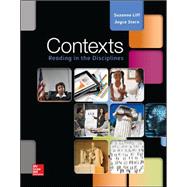Contexts: Reading in the Disciplines engages students personally, actively, and critically through an integrated print and digital program designed to prepare them for college—and lifelong—reading.
Here’s how: Eight scaffolded modules help students move from guided to independent reading with selections that are personal and relevant to their lives. Each module is arranged from least to most challenging in terms of reading level and includes pre- and post-reading activities that encourage students to think critically, to summarize, and to synthesize what they have learned. By helping students move from practicing to applying, the modules meet a program’s goals of making students independent readers. Modules also promote vocabulary enhancement through the integration of vocabulary exercises. In addition to the scaffolded modules, integration of metacognitive strategies, and Connect Reading, Contexts: Reading in the Disciplines provides instruction to strengthen comprehension and critical reading skills. Contexts: Reading in the Disciplines uses authentic material allowing students to unlock textbook content across academic disciplines.
Based on developmental education and literacy research and with a tested pedagogical system to scaffold student learning, McGraw-Hill’s Contexts: Reading in the Disciplines helps students in upperlevel reading courses become critical readers and active participants in their own learning as they move from guided to independent reading and gain confidence in their skills. Contextualization of reading skills and strategies within freshman experience content is the cornerstone of this textbook. Its unique two-part organization helps to support this approach by containing instructional chapters focusing on a single academic discipline, and theme-based reading selection modules in the second part center around a high-interest topic or theme often addressed in freshman experience topics.








